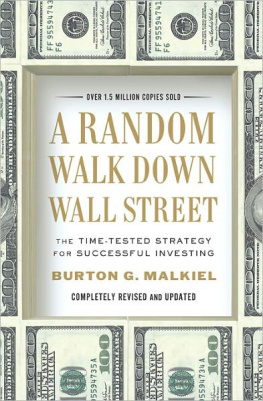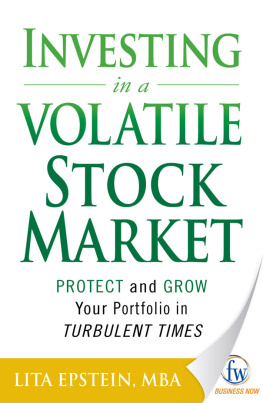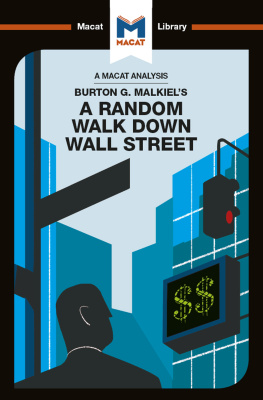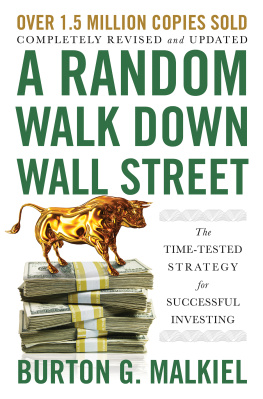A RANDOM WALK DOWN WALL STREET
The Time-Tested Strategy for Successful Investing
BURTON G. MALKIEL

W. W. NORTON & COMPANY
New York London
Copyright 2011, 2007, 2003, 1999, 1996, 1990, 1985, 1981, 1975, 1973 by W. W. Norton & Company, Inc.
The article on page 324 entitled Red Faces in Park appears courtesy of Thomson Reuters. All rights reserved. Republication or redistribution of Thomson Reuters content, including by framing or similar means, is expressly prohibited without the prior written consent of Thomson Reuters. Thomson Reuters and its logo are registered trademarks or trademarks of the Thomson Reuters group of companies around the world. Thomson Reuters 2009. Thomson Reuters journalists are subject to an Editorial Handbook, which requires fair presentation and disclosure of relevant interests.
All rights reserved
For information about permission to reproduce selections from this book, write to Permissions, W. W. Norton & Company, Inc., 500 Fifth Avenue, New York, NY 10110
Library of Congress Cataloging-in-Publication Data
Malkiel, Burton Gordon.
A random walk down Wall Street: the time-tested strategy for successful investing / Burton G. Malkiel.
p. cm.
Rev. ed.
ISBN: 978-0-393-08169-5
1. Investments. 2. Stocks. 3. Random walks (Mathematics) I. Title.
HG4521.M284 2011
332.601519282dc22
2010041866
W. W. Norton & Company, Inc.
500 Fifth Avenue, New York, N.Y. 10110
www.wwnorton.com
W. W. Norton & Company Ltd.
Castle House, 75/76 Wells Street, London W1T 3QT
TO NANCY AND SKIPPER
CONTENTS
PREFACE
IT HAS NOW been forty years since I began writing the first edition of A Random Walk Down Wall Street . The message of the original edition was a very simple one: Investors would be far better off buying and holding an index fund than attempting to buy and sell individual securities or actively managed mutual funds. I boldly stated that buying and holding all the stocks in a broad stock-market average was likely to outperform professionally managed funds whose high expense charges and large trading costs detract substantially from investment returns.
Now, forty years later, I believe even more strongly in that original thesis, and theres more than a six-figure gain to prove it. I can make the case with great simplicity. An investor with $10,000 at the start of 1969 who invested in a Standard & Poors 500-Stock Index Fund would have had a portfolio worth $463,000 by 2010, assuming that all dividends were reinvested. A second investor who instead purchased shares in the average actively managed fund would have seen his investment grow to $258,000. The difference is dramatic. Through May 30, 2010, the index investor was ahead by $205,000, an amount almost 80 percent greater than the final stake of the average investor in a managed fund.
Why, then, a tenth edition of this book? If the basic message hasnt changed, what has? The answer is that there have been enormous changes in the financial instruments available to the public. A book meant to provide a comprehensive investment guide for individual investors needs to be updated to cover the full range of investment products available. In addition, investors can benefit from a critical analysis of the wealth of new information provided by academic researchers and market professionalsmade comprehensible in prose accessible to everyone with an interest in investing. There have been so many bewildering claims about the stock market that its important to have a book that sets the record straight.
Over the past forty years, we have become accustomed to accepting the rapid pace of technological change in our physical environment. Innovations such as e-mail, the Internet, iPhones, iPads, Kindles, videoconferencing, social networks, and new medical advances ranging from organ transplants and laser surgery to nonsurgical methods of treating kidney stones and unclogging arteries have materially affected the way we live. Financial innovation over the same period has been equally rapid. In 1973, when the first edition of this book appeared, we did not have money-market funds, NOW accounts, ATMs, index mutual funds, ETFs, tax-exempt funds, emerging-market funds, target-date funds, floating-rate notes, volatility derivatives, inflation protection securities, equity REITs, asset-backed securities, Roth IRAs, 529 college savings plans, zero-coupon bonds, financial and commodity futures and options, and new trading techniques such as portfolio insurance and flash trading, to mention just a few of the changes that have occurred in the financial environment. Much of the new material in this book has been included to explain these financial innovations and to show how you as a consumer can benefit from them.
This tenth edition also provides a clear and easily accessible description of the academic advances in investment theory and practice. Chapter 10 describes the exciting new field of behavioral finance and underscores the important lessons investors should learn from the insights of the behavioralists. In addition, a new section has been added to present practical investment strategies for investors who have retired or are about to retire. So much new material has been added over the years that readers who may have read an earlier edition of this book in college or business school will find this new edition rewarding reading.
This edition takes a hard look at the basic thesis of earlier editions of Random Walk that the market prices stocks so efficiently that a blindfolded chimpanzee throwing darts at the stock listings can select a portfolio that performs as well as those managed by the experts. Through the past forty years, that thesis has held up remarkably well. More than two-thirds of professional portfolio managers have been outperformed by the unmanaged S&P 500 Index. Nevertheless, there are still both academics and practitioners who doubt the validity of the theory. And the stock-market crash of October 1987, the Internet bubble, and the financial crisis of 200809 raised further questions concerning the vaunted efficiency of the market. This edition explains the recent controversy and reexamines the claim that its possible to beat the market. I conclude in chapter 11 that reports of the death of the efficient-market theory are vastly exaggerated. I will, however, review the evidence on a number of techniques of stock selection that are believed to tilt the odds of success in favor of the individual investor.
The book remains fundamentally a readable investment guide for individual investors. As I have counseled individuals and families about financial strategy, it has become increasingly clear to me that ones capacity for risk-bearing depends importantly upon ones age and ability to earn income from noninvestment sources. It is also the case that the risk involved in most investments decreases with the length of time the investment can be held. For these reasons, optimal investment strategies must be age-related. Chapter 14, entitled A Life-Cycle Guide to Investing, should prove very helpful to people of all ages. This chapter alone is worth the cost of a high-priced appointment with a personal financial adviser.
My debts of gratitude to those mentioned in earlier editions continue. In addition, I must mention the names of a number of people who were particularly helpful in making special contributions to the tenth edition. I am especially indebted to Kevin Laughlin of the Bogle Research Institute, to my Princeton colleague Harrison Hong, and to my research assistants, David Hou, Derek Jun, and Saumitra Sahi. I am also grateful to John Devereaux, Christopher Philips, and Cheryl Roberts of the Vanguard Group for their important assistance in providing data.








